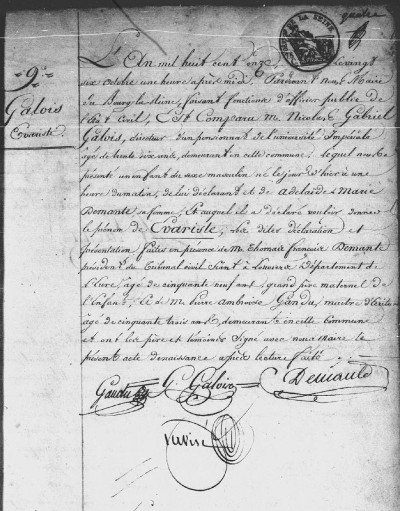Link person - act
Acts are related to persons through the fieldacts of a person.
Field
acts contains one or more paths.
Ex:
paths: [
- "birth/1811/10/25/galois-evariste-1811-10-25"
]
These paths designate directories, relative to variable paths / acts of config.yml.
paths: acts: /path/to/acts
Directory layout
Acts are organized chronologically :
acts
└── birth
└── 1811
└── 10
└── 25
└── galois-evariste-1811-10-25
├── naissance.jpg
└── naissance.yml
Example for Evariste Galois, Bourg-la-Reine, France, 1811-10-25 01:00
Detailed transcription
A syntax used for a genealogy software permits a complete transcription of a BC.This is shown as an example, but this syntax is not used by g5.
Act
An act consists of 2 documents :- The image of the scan of the original document
-
A yaml file with structured informations containing
- ideally, a transcription of the act
- An url The way to easily go back to the document published by the administration.
The following informations are necessary :
(in parentheses, corresponding fieldname in g5 vocabulary of entity Person).
- Country (birth.place.cy)
- Département (birth.place.c2)
- City (birth.place.name)
- Arrondissement (birth.place.c3), for Paris, Lyon, Marseille (arrondissement = part of a city).
This information is important because without it, it's very difficult to find the registry. - Name of the registry
-
Page number where the birth certificate is located within the registry.
Important because finding the right page may be a long process. - If possible, the url directly pointing to the page. Some départements provide a way to copy the "permalink" of a document, which may be different from the url of the page displayed by the web browser.
Image download
Some départements provide a link to download current page, some don't. When they don't, image retrieval is done with screen capture. This can be particularily long because sometimes several captures may be necessary to get the whole certificate with enough details. In this case, the image is reconstituted assembling the different parts.Syntax
The syntax used to transcribe the acts comes from an unpublished genealogy software.YAML files are written using french vocabulary, and are translated to a reference vocabulary (close to english) understood by the code parsing the yaml files. This permits to use other languages for the transcription.
This syntax is adapted to act transcription and contains informations currently not used for g5 development.
Gauquelin5 integration
Not done yet ; code transfering information fromacts/ to g5 database needs to be written.
Currently, when an information of the database needs to be corrected (because it contradicts an act), this is done using the tweak2tmp mechanism.
French archives
In France, all acts (birth, death, mariage) since 1792 include the time of the events.Scans of the original documents until ~1920 can be browsed on web sites of the Archives départementales.
This makes 5 generations, around 200 millions of documents, originally scanned by Mormons (The Church of Jesus Christ of Latter-day Saints) in the 1980s.
Times are often rounded to the hour.
To see original acts, type on a search engine for example "archives 45" (or maybe "Archives 45 France") to see the archives départementales du Loiret (Loiret is département n° 45).
Here lies potential data to test astral heredity at large scale, but not (yet ?) in the scope of g5 program.
filae.com
Page Etat-civil numérisé : d’où viennent les données says they have numerized the quasi-totality of french civil registries of the XIXth century, since revolution (1792).More than 100 millions pages representing 200 millions acts.
Limits :
- Birth : acts older than 120 years
- Mariage : acts older than 104 years
- Death : acts older than 75 years
Local associations
Numerous individuals and local associations have transcribed (typed in electronic format) acts. For a part, data are closed, reserved to the associations adherents.But part of these data are open, a quite dynamic ecosystem, with free software to assist act transcription, and millions of acts available from heterogenous sources, and (in general ?) without birth time mentioned.
-
Nimègue is a software used by genealogists to transcribe various types of acts (actes paroissiaux, d'état civil, notariés): civil registry, church, notary + army, hospital, justice.
Very sad : Time is not handled by Nimègue. The form to create a new act contains only the day. -
ExpoActesSoftware permitting to import and publish data - from Nimègue, csv,
From Inventaire des sites ExpoActes
Part of these data can be browsed, part are reserved to the associations' members.Births Naissances 41 456 522 Mariages Mariages 16 788 234 Death Décès 29 431 962 Miscelaneous Divers 9 844 697 Total 97 521 415
Didn't find way to download the data.
(data 2020-11-21) -
58 genealogical associations
63 774 310 acts transcribed
224 023 107 persons indexed
(data 2020-11-21) -
Gathers data from 100 local associations
109 420 603 acts dated between 1358 and 1935.
(data 2020-11-20)
